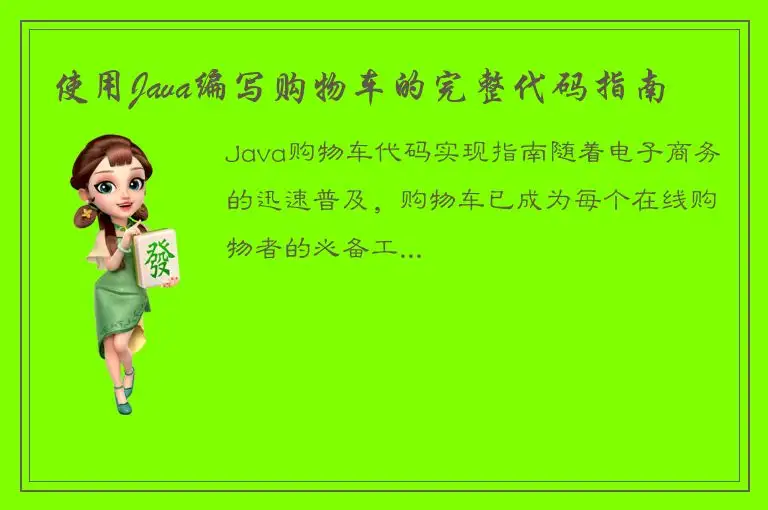Java购物车代码实现指南

随着电子商务的迅速普及,购物车已成为每个在线购物者的必备工具之一。那么,如何使用Java编写购物车的完整代码呢?在本文中,我们将介绍几个关键的步骤和实现要点,帮助你了解Java购物车代码的实现方法。
1. 定义数据结构
购物车需要存储的数据包括商品名称、价格、数量和总价等信息。因此,我们需要定义一个数据结构来存储这些信息。可以使用Java中的实体类来实现,比如:
```java
public class Item {
private String name;
private double price;
private int quantity;
public Item(String name, double price, int quantity) {
this.name = name;
this.price = price;
this.quantity = quantity;
}
public String getName() {
return name;
}
public double getPrice() {
return price;
}
public int getQuantity() {
return quantity;
}
public double getTotalPrice() {
return price * quantity;
}
}
```
这个实体类可以存储商品的名称、价格、数量和总价信息,并提供相应的getter方法供代码调用。
2. 创建购物车
购物车可以用一种简单的数组来实现,其中每个元素存储购物车中的一个商品。可以使用下面的代码来创建购物车:
```java
public class ShoppingCart {
private List
public ShoppingCart() {
items = new ArrayList<>();
}
public void addItem(Item item) {
items.add(item);
}
public void removeItem(Item item) {
items.remove(item);
}
public double getTotalPrice() {
double totalPrice = 0;
for (Item item : items) {
totalPrice += item.getTotalPrice();
}
return totalPrice;
}
public List
return items;
}
}
```
创建了一个ShoppingCart类,其中包含了一个Item类型的数组,以及添加、删除、获取购物车中的商品和计算购物车总价的方法。
3. 实现购物车界面
购物车界面应该能够显示购物车中的商品,并允许用户修改购物车中商品的数量或者删除商品。可以使用Java Swing来实现购物车界面,比如:
```java
public class ShoppingCartGUI {
private JFrame frame;
private JTable table;
private ShoppingCart cart;
public ShoppingCartGUI() {
cart = new ShoppingCart();
frame = new JFrame();
frame.setBounds(100, 100, 500, 300);
frame.setDefaultCloseOperation(JFrame.EXIT_ON_CLOSE);
// Create JTable and add to JScrollPane
table = new JTable();
JScrollPane scrollPane = new JScrollPane(table);
frame.getContentPane().add(scrollPane, BorderLayout.CENTER);
// Create panel and add buttons
JPanel panel = new JPanel();
frame.getContentPane().add(panel, BorderLayout.SOUTH);
JButton btnAdd = new JButton("Add Item");
panel.add(btnAdd);
JButton btnRemove = new JButton("Remove Item");
panel.add(btnRemove);
// Add action listeners to buttons
btnAdd.addActionListener(new ActionListener() {
public void actionPerformed(ActionEvent e) {
// Show Add Item dialog
AddItemDialog dialog = new AddItemDialog(frame, true);
dialog.setVisible(true);
// Add Item to cart
if (dialog.isOkPressed()) {
Item item = dialog.getItem();
cart.addItem(item);
table.setModel(new ItemTableModel(cart.getItems()));
}
}
});
btnRemove.addActionListener(new ActionListener() {
public void actionPerformed(ActionEvent e) {
// Get selected item and remove from cart
int selectedIndex = table.getSelectedRow();
if (selectedIndex >= 0) {
Item item = cart.getItems().get(selectedIndex);
cart.removeItem(item);
table.setModel(new ItemTableModel(cart.getItems()));
}
}
});
}
public void show() {
// Set table model and show frame
table.setModel(new ItemTableModel(cart.getItems()));
frame.setVisible(true);
}
}
```
在这个代码中,我们创建了一个ShoppingCartGUI类,其中包含了一个JFrame窗口、一个JTable表格、两个JButton按钮和一个ShoppingCart购物车对象。在界面上能够添加商品、删除商品,并通过调用TableModel的实现类完整地显示购物车中的所有条目。
4. 编写TableModel的实现
我们之前创建了一个存储商品信息的实体类(Item),以及一个关于购物车的核心类(ShoppingCart)。接下来,我们需要编写一个TableModel实现类(ItemTableModel),将购物车中的所有Item信息展示在GUI界面上的JTable表格中:
```java
public class ItemTableModel extends AbstractTableModel {
private List
private String[] columnNames = {"Name", "Price", "Quantity", "Total Price"};
public ItemTableModel(List
this.items = items;
}
public int getColumnCount() {
return columnNames.length;
}
public int getRowCount() {
return items.size();
}
public String getColumnName(int col) {
return columnNames[col];
}
public Object getValueAt(int row, int col) {
Item item = items.get(row);
switch (col) {
case 0:
return item.getName();
case 1:
return item.getPrice();
case 2:
return item.getQuantity();
case 3:
return item.getTotalPrice();
default:
return null;
}
}
public Class getColumnClass(int c) {
return getValueAt(0, c).getClass();
}
public boolean isCellEditable(int row, int col) {
return false;
}
}
```
上述代码中的ItemTableModel类扩展了AbstractTableModel类,并重写了getColumnCount()、getRowCount()、getColumnName()等方法,从购物车中的ItemList中取出了所有的商品信息。在getValueAt()方法中,我们将根据所需的列索引返回不同的值,获取商品名称(name)、商品价格(price)、商品数量(quantity)和商品总价(totalPrice)等信息,将这些信息返回到表格的指定位置。
5. 创建添加商品的对话框
最后,我们需要创建一个对话框,让用户可以添加商品到购物车。对话框应该包括商品名称、价格和数量等信息的输入框。可以使用Java Swing来创建这个对话框,比如:
```java
public class AddItemDialog extends JDialog {
private JTextField txtName;
private JTextField txtPrice;
private JTextField txtQuantity;
private boolean isOkPressed;
private Item item;
public AddItemDialog(Frame parent, boolean modal) {
super(parent, modal);
setTitle("Add Item");
setBounds(100, 100, 300, 200);
setLayout(new BorderLayout());
// Create panel and add text fields
JPanel panel = new JPanel();
add(panel, BorderLayout.CENTER);
JLabel lblName = new JLabel("Name:");
panel.add(lblName);
txtName = new JTextField();
txtName.setColumns(10);
panel.add(txtName);
JLabel lblPrice = new JLabel("Price:");
panel.add(lblPrice);
txtPrice = new JTextField();
txtPrice.setColumns(10);
panel.add(txtPrice);
JLabel lblQuantity = new JLabel("Quantity:");
panel.add(lblQuantity);
txtQuantity = new JTextField();
txtQuantity.setColumns(10);
panel.add(txtQuantity);
// Create OK and Cancel buttons
JPanel buttonPanel = new JPanel();
add(buttonPanel, BorderLayout.SOUTH);
JButton btnOk = new JButton("OK");
buttonPanel.add(btnOk);
JButton btnCancel = new JButton("Cancel");
buttonPanel.add(btnCancel);
// Add action listeners to buttons
btnOk.addActionListener(new ActionListener() {
public void actionPerformed(ActionEvent e) {
try {
String name = txtName.getText();
double price = Double.parseDouble(txtPrice.getText());
int quantity = Integer.parseInt(txtQuantity.getText());
item = new Item(name, price, quantity);
isOkPressed = true;
} catch (NumberFormatException ex) {
JOptionPane.showMessageDialog(AddItemDialog.this, "Invalid input!");
return;
}
dispose();
}
});
btnCancel.addActionListener(new ActionListener() {
public void actionPerformed(ActionEvent e) {
isOkPressed = false;
dispose();
}
});
}
public boolean isOkPressed() {
return isOkPressed;
}
public Item getItem() {
return item;
}
}
```
在这个代码中,我们创建了一个AddItemDialog类,它继承了JDialog类,用于获取商品的名称、价格和数量,并将新的Item对象添加到购物车中。
至此,我们就实现了一个Java购物车代码的完整实现。我们定义了一个Item类,用于存储商品信息;创建了一个ShoppingCart购物车类,用于管理购物车,在此过程中,可以执行添加和删除操作;并设置购物车GUI,用于将购物车的内容显示在窗口中;同时,为了防止输入错误,我们还创建了一个对话框用于获取商品信息。通过上述方法的定义和实现,你可以轻松地使用Java编写出一个外观完美且功能强大的购物车代码。




 QQ客服专员
QQ客服专员 电话客服专员
电话客服专员